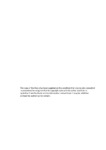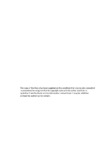Collage in the Posthuman Era: Gender and Becoming
| dc.contributor.supervisor | Gonzalez, Laura | |
| dc.contributor.author | Hart, Margaret | |
| dc.contributor.other | School of Art, Design and Architecture | en_US |
| dc.date.accessioned | 2021-01-05T11:07:30Z | |
| dc.date.issued | 2020 | |
| dc.identifier | 10511790 | en_US |
| dc.identifier.uri | http://hdl.handle.net/10026.1/16779 | |
| dc.description.abstract |
This thesis researches collage as a tool to address gender in a posthuman framework and was designed to examine one question: How can collage contribute to a posthuman understanding of gender? This investigation strives to get beyond the pitfalls of binary gender identification prevalent within humanistic approaches to gender studies in the liberal arts through the creation of a body of artworks which visually depict posthuman tenets (variation, multiplicity, non—hierarchical relations, fluidity, interconnectedness and transformation) through interactions between human and non—human agents. Developed by a practicing artist who embraces becoming and working within a posthuman framework, this project defines a set of Posthuman Collage Operations (separating, joining, political potency, speculation and zigzagging) as an original contribution to new knowledge. These operations are transferable to other artist—researchers who create collage artworks and have implications within the fields of art, gender studies and experimental fiction. This practice—as—research project, incorporating visual collage, animation and experimental writing, guided via key texts by philosopher Rosi Braidotti and feminist scholar Donna Haraway, culminated materially in the creation of a series of two—dimensional collage works and a video animation exhibited under the title Situated Becomings. By defining and working with an experimental practice—as—research methodology, a variation of philosopher Claude Lévi—Strauss’ bricoleur methodology (Lévi—Strauss, 1966), and informed by philosophers Gilles Deleuze and Felix Guattari’s becoming—woman model (Deleuze and Guattari, 1987) combined with Braidotti’s affirmative emergent ontology (Braidotti, 2013), three methods were employed to complete this work. The methods are collage, reflection and critical case studies of works by artists Hannah Höch, Miriam Schapiro and Wangechi Mutu. The collages created for this project are derived from a self—authored nonlinear science fiction text centered on a main character named Mear, who can transition genders through the use of technology. My private practice science fiction writing is part of my creative process in this research; it is carried out as theorist Darren Hudson Hick and literary critic Kenneth Goldsmith characterize conceptual writing, where methods of fragmentation and reframing become part of the practice, mirroring the visual collage method employed (Goldsmith, 2011; Hick, 2013). The methods of collage, reflection, and case studies combine in this project to lead to artworks which envision imaginative new creations of gender and subjectivity. | en_US |
| dc.language.iso | en | |
| dc.publisher | University of Plymouth | |
| dc.subject | Collage | en_US |
| dc.subject | Gender | |
| dc.subject | Posthuman | |
| dc.subject | Art | |
| dc.subject | Becoming | |
| dc.subject | Science Fiction | |
| dc.subject | Animation | |
| dc.subject.classification | PhD | en_US |
| dc.title | Collage in the Posthuman Era: Gender and Becoming | en_US |
| dc.type | Thesis | |
| plymouth.version | non-publishable | en_US |
| dc.identifier.doi | http://dx.doi.org/10.24382/1135 | |
| dc.identifier.doi | http://dx.doi.org/10.24382/1135 | |
| dc.type.qualification | Doctorate | en_US |
| rioxxterms.version | NA |
Files in this item
This item appears in the following Collection(s)
-
01 Research Theses Main Collection
Research Theses Main



